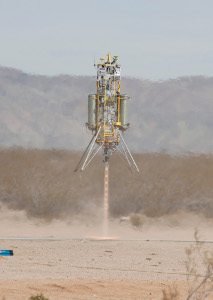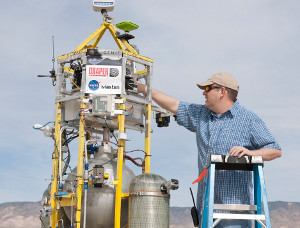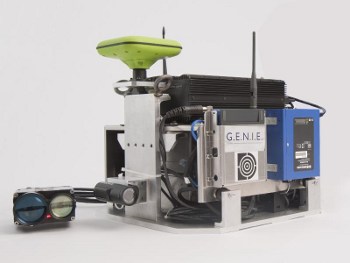 |
| April 09, 2013 | Volume 09 Issue 14 |
Designfax weekly eMagazine
Archives
Partners
Manufacturing Center
Product Spotlight
Modern Applications News
Metalworking Ideas For
Today's Job Shops
Tooling and Production
Strategies for large
metalworking plants
NASA Dryden tests Xombie suborbital rocket for planet, asteroid landings and takeoffs

Masten Space Systems' Xombie space-access technology demonstrator lifts off on its highest and longest flight to date, guided by Draper Lab's GENIE navigation and control system.
A rocket-powered, vertical-landing, space-access technology demonstrator reached its highest altitude and furthest distance to date March 25 at the Mojave Air and Space Port in Mojave, CA, using a developmental navigation system designed to land a space vehicle on other celestial bodies. The project is fueled by a growing interest in vertical takeoff and landing with commercial suborbital launch vehicles.
Masten Space Systems' XA-0.1B "Xombie" suborbital rocket lifted off the launch pad for an 80-sec flight while being controlled by Charles Stark Draper Laboratory's Guidance Embedded Navigator Integration Environment (GENIE) system developed under NASA's Flight Opportunities Program.
This combined capability of a rocket-powered demonstrator and a closed-loop planetary guidance, navigation, and control system allows NASA to begin testing prototype landing instruments for future missions to the moon or Mars under realistic conditions without leaving Earth. The rocket is powered by isopropyl alcohol.
"Two hundred meters above the Martian or lunar surface is not the place you want to be using an innovative new sensor or landing algorithm for the first time," explained Christopher Baker of the Flight Opportunities Program at NASA's Dryden Flight Research Center at Edwards Air Force Base. "We are working to create an environment that provides opportunities to test these systems a little closer to home."
Xombie rose 1,626 ft, or nearly 500 m -- higher than New York's Empire State Building -- moving in a trajectory that replicated the speed and angle of a planetary approach. It landed 984 ft (300 m) away from the takeoff site. The flight established a test-bed capability that will allow for landing demonstrations that start at much higher altitudes -- several miles above the ground.
"While computer simulations provide some value as systems are developed, testing that system in a relevant flight environment is invaluable," said Colin Ake, Masten's director of business development. "We want our vehicles to facilitate innovation and lower the current barriers to space access. We hope this is just the beginning of many more landing tests for NASA and Draper."
With a growing interest in using commercial suborbital launch vehicles to demonstrate planetary landing technology applications for future space missions, the Flight Opportunities Program funded the development of precision landing technology demonstrations.

Tye Brady, principal investigator for Draper Lab's GENIE flight control system, makes final adjustments to the system on Masten Space Systems' Xombie technology demonstration rocket before liftoff.
Draper, based in Cambridge, MA, was selected to lead this engineering and integration demonstration effort. Draper subsequently teamed with Masten, based in Mojave, to provide the vertical takeoff and landing flight vehicle to demonstrate this new landing technology. Flight safety and assurance monitoring was performed by Masten's Sensei software during flight.
"We believe the GENIE and Xombie system provide NASA with the platform necessary to demonstrate a wide range of exciting planetary landing technologies, including advanced guidance technology," said Doug Zimpfer, Draper's associate director for human space exploration.
Flight Opportunities initiated the test efforts in December 2011. The flights built incrementally on ground simulations, tethered flights, and closed-loop flight demonstrations. The most recent flight demonstrated an expanded Xombie and GENIE envelope for precision planetary landing that includes enough margin to integrate additional landing sensor technologies in the future.

NASA Dryden engaged Draper Laboratory to develop the GENIE flight control system to guide the flight of Masten Space Systems' Xombie technology demonstrator. [Photo by Draper Lab]
The Flight Opportunities Program, part of NASA's Space Technology Mission Directorate, is enabling demonstration and maturation of new technology payloads using suborbital reusable launch vehicles, high-altitude balloons, and parabolic aircraft to expose technology payloads to space-relevant environments of reduced-gravity or near-space flights.
The program facilitates low-cost access to suborbital environments for a broad range of innovators as a means of advancing space technology development and supporting the evolving entrepreneurial commercial space industry.
The Space Technology Mission Directorate will develop the cross-cutting, advanced, and pioneering new technologies needed for NASA's current and future missions, many of which also benefit America's aerospace industries and other government agencies, and address national needs.
Source: NASA Dryden Flight Research Center
Published April 2013
Rate this article
View our terms of use and privacy policy
